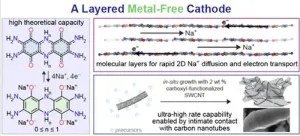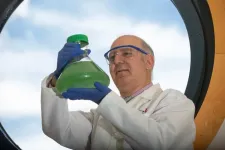(Press-News.org) The Columbia Climate School has announced the first master’s degree program in the United States for climate finance. In close collaboration with the Columbia Business School, this interdisciplinary degree will drive impactful solutions to the climate crisis through advanced financial tools and scientific knowledge. This is the third master’s program announced by the Climate School, in addition to an M.A. in Climate and Society and an M.S. in Climate degree.
“The world needs problem-solvers to address the global climate crisis,” said Alexis Abramson, dean of the Columbia Climate School. “Everyone at the Climate School is committed to developing solutions, and bringing together fields like climate and finance as a multidisciplinary approach is pivotal, as we need all hands on deck to respond to this urgent global challenge.”
The M.S. in Climate Finance is a one-year degree combining courses in climate science, adaptation and mitigation strategies, international climate finance, capital markets, energy and infrastructure financing, and more. The first group of students will begin classes in fall 2025.
“By collaborating with the business school, we are able to provide students with not just a foundation in core climate science but also fundamental business acumen,” said Climate School senior vice dean Jeff Shaman. “It will equip students with the financial decision-making skills needed to respond to the climate crisis.”
“Climate change is going to impact every sector and all aspects of our lives,” said Costis Maglaras, dean of Columbia Business School. “Only by combining ideas from climate science and finance can we address these challenges.”
The new program meets a growing need in public and private financial institutions, as well as within multilateral organizations and the public sector, to assess risks and opportunities associated with climate change, and to identify pathways to mobilize critical finance.
“There is a real demand in business and finance for practitioners who understand climate variability, climate risk, the difference between mitigation and adaptation, and emerging investment opportunities,” said Lisa Sachs, director of the Columbia Center on Sustainable Investment, associate professor at the Climate School and director of the new Climate Finance program. “And there is a global demand for graduates who understand the challenges of climate finance and have the expertise to close the financing gaps.”
Graduates of the program will bring unique knowledge, skill sets and networks to solutions-oriented positions in the business sector, public and private financial institutions, development finance institutions, global climate-finance initiatives, ministries of finance and civil society.
All of these institutions need practitioners who understand the complex interactions of climate and finance, to navigate the evolving imperatives and expectations on the private sector to understand risks and contribute to solutions, and to lead impactful reforms and approaches to drive impact through public and international institutions.
“The program is designed to attract a diverse student body and individuals at different stages in their careers,” said Bruce Usher, a professor of professional practice at the Climate School and at the Columbia Business School. “The M.S. in Climate Finance degree will prepare graduates to use the latest climate knowledge and financial expertise to implement practical solutions to climate change globally.”
As part of the new climate finance degree, the Columbia Climate School will be offering Stanley Park Climate Finance scholarships to cultivate a new generation of professionals equipped to integrate expertise in climate and finance to address the climate crisis. The scholarships will be awarded through a competitive application process and are open to applicants with demonstrated financial need and an intention of contributing to the public and nonprofit sectors, and particularly those from countries with emerging and developing economies.
With New York City—the world’s leading financial hub and home of the United Nations—as backdrop for the program, students will regularly interface with preeminent practitioners from finance, industry, the public sector and global organizations.
“This degree combines the best of two extraordinary schools at Columbia University: the Climate School and the Business School,” said Sachs. “It’s critical to understand the implications and opportunities for public and private finance in responding to climate change, drawing on world-class faculty and leading experts in each discipline.”
END
Columbia Climate School launches M.S. in Climate Finance
First such program in the United States
2025-02-19
ELSE PRESS RELEASES FROM THIS DATE:
MD Anderson receives nearly $23 million in CPRIT funding for cancer research, faculty recruitment
2025-02-19
HOUSTON ― The University of Texas MD Anderson Cancer Center today was awarded nearly $23 million from the Cancer Prevention and Research Institute of Texas (CPRIT) in support of 20 cancer research projects to advance new breakthroughs in discovery, translational, clinical and prevention science. In addition, CPRIT awarded $2 million for the recruitment of one first-time, tenure-track faculty member.
“We sincerely appreciate CPRIT’s continued funding of impactful cancer research that will help us achieve our mission to end cancer,” said ...
A new way to observe electrons in motion
2025-02-19
Electrons oscillate around the nucleus of an atom on extremely short timescales, typically completing a cycle in just a few hundred attoseconds (one attosecond is a quintillionth of a second). Because of their ultrafast motions, directly observing electron behavior in molecules has been challenging. Now researchers from UC San Diego’s Department of Chemistry and Biochemistry have suggested a new method to make visualizing electron motion a reality.
This new method describes an experimental concept called ultrafast vortex electron diffraction, which allows ...
Study reveals palm trees once thrived in subarctic Canada
2025-02-19
New London, Conn. — A new study by Connecticut College provides strong evidence that palm trees once thrived in subarctic Canada, reshaping scientific understanding of past Arctic climates.
Conn Professor Peter Siver’s research, published in the journal Annals of Botany, confirms that during the late early Eocene—approximately 48 million years ago—this region maintained warm temperatures year-round, even during months of winter darkness. The work was done in collaboration with colleagues from Canada and Poland.
Siver’s team identified fossilized phytoliths—microscopic ...
Is smoking tied to unexplained stroke in younger adults?
2025-02-19
MINNEAPOLIS — Smoking, particularly heavy smoking, is linked to some unexplained strokes in younger adults, mainly in male individuals and in people ages 45 to 49, according to a study published in the February 19, 2025, online issue of Neurology® Open Access, an official journal of the American Academy of Neurology.
A stroke with no known cause, called a cryptogenic stroke, is a type of ischemic stroke caused by a blockage of blood flow, but it is unclear what has caused the blockage. Symptoms include weakness, trouble speaking and vision problems. Strokes can be fatal. Most strokes occur after age 65.
“While smoking has long been linked to ischemic stroke, ...
Princeton Chemistry demonstrates high-performance Sodium-ion cathode towards new battery technology
2025-02-19
For decades, scientists have sought ways to counter our dependence on lithium-ion batteries. These traditional, rechargeable batteries energize today’s most ubiquitous consumer electronics – from laptops to cell phones to electric cars. But raw lithium is expensive and is often sourced through fragile geopolitical networks.
This month, Princeton University’s Dincă Group announces an exciting alternative that relies on an organic, high-energy cathode material to make sodium-ion batteries, advancing the likelihood that this technology will find commercialization with safe, cheaper, more sustainable components.
While scientists ...
New study links dust storms to increased emergency department visits in the U.S. Southwest
2025-02-19
DENVER - A new research study highlights the significant health risks associated with dust storms, revealing an increase in emergency department (ED) visits for respiratory and cardiovascular conditions, as well as motor vehicle accidents, in three Southwestern U.S. states. The study, which was led at National Jewish Health was published this month in JAMA Network Open.
Researchers at National Jewish Health, Emory University and the University of Colorado analyzed over 33,500 ED visits across Arizona, California and Utah from 2005 to 2018. The findings ...
Stopping asthma in its tracks
2025-02-19
LA JOLLA, CA—Current asthma treatments don't work in all patients, and they don't provide long-term relief from potentially deadly asthma attacks.
Scientists at La Jolla Institute for Immunology (LJI) are advancing a new kind of therapy. According to a recent study published in the Journal of Allergy and Clinical Immunology, their approach holds promise for providing long-lasting relief for people with asthma—and it may be useful for dampening immune inflammation in general.
The researchers have developed two therapeutic ...
Chlorine plus UV light degrades toxins caused by harmful algae blooms
2025-02-19
Treatment plants use a combination of tools to keep toxins and contaminants out of drinking water.
Researchers with the University of Cincinnati examined two such tools in addressing a toxin produced by harmful algae blooms, which are becoming increasingly common in waters around the world.
Blue green algae can reproduce en masse in waters laden with nitrogen, phosphorus or other excess nutrients. These algae “blooms” also can form when water levels drop during droughts or when bottom sediments heavy with nutrients get churned up in a storm, said Minghao Kong, a doctoral graduate of UC’s ...
In Denmark, rural cat owners are neutering their cats and allowing them indoor access
2025-02-19
Cat owners in the Denmark countryside are increasingly managing their cats in the same way as urban cat owners, resulting in fewer unwanted kittens being born, according to a study published February 19, 2025, in the open-access journal PLOS One by Peter Sandøe from the University of Copenhagen, Denmark, and colleagues.
Populations of unowned domestic cats – whether unsocialized feral cats that have never lived with humans, or socialized cats that have strayed or been abandoned – are regarded as problematic in many countries. It is argued that they are a nuisance, that they transmit disease to humans, owned cats and ...
Young people who use multiple muscle-building supplements are more likely to report symptoms of muscle dysmorphia
2025-02-19
Young people who use multiple muscle-building supplements are more likely to report symptoms of muscle dysmorphia, per Canadian study of more than 2,500 adolescents and young adults.
####
Article URL: https://plos.io/3EyuhD6
Article Title: Muscle-building supplement use is associated with muscle dysmorphia symptomatology among Canadian adolescents and young adults
Author Countries: Canada, France, U.S.
Funding: This study was funded by the Connaught New Researcher Award (#512586; KTG) at the University of Toronto. The funders had no role in study design, ...
LAST 30 PRESS RELEASES:
New study highlights link between eviction rates and gun violence
Heatwaves heat up soil but not toxin levels in rice, study finds
Digital modeling reveals where construction carbon emissions really come from
Turning farm waste into water filters
New study shows how the spleen helps the immune system accept a transplant
New Mayo Clinic study advances personalized prostate cancer education with an EHR-integrated AI agent
Researchers identify novel therapeutic target to improve recovery after nerve injury
Microbes in breast milk help populate infant gut microbiomes
Reprogramming immunity to rewrite the story of Type 1 diabetes
New tool narrows the search for ideal material structures
Artificial saliva containing sugarcane protein helps protect the teeth of patients with head and neck cancer
Understanding the role of linear ubiquitination in T-tubule biogenesis
Researchers identify urban atmosphere as primary reservoir of microplastics
World’s oldest arrow poison – 60,000-year-old traces reveal early advanced hunting techniques
Bristol scientists discover early sponges were soft
New study uncovers how rice viruses manipulate plant defenses to protect insect vectors
NSF–DOE Vera C. Rubin Observatory spots record-breaking asteroid in pre-survey observations
Ribosomal engineering creates “super-probiotic” bacteria
This self-powered eye tracker harnesses energy from blinking and is as comfortable as everyday glasses
Adverse prenatal exposures linked to higher rates of mental health issues, brain changes in adolescents
Restoring mitochondria shows promise for treating chronic nerve pain
Nature study identifies a molecular switch that controls transitions between single-celled and multicellular forms
USU chemists' CRISPR discovery could lead to single diagnostic test for COVID, flu, RSV
Early hominins from Morocco reveal an African lineage near the root of Homo sapiens
Small chimps, big risks: What chimps show us about our own behavior
We finally know how the most common types of planets are created
Thirty-year risk of cardiovascular disease among healthy women according to clinical thresholds of lipoprotein(a)
Yoga for opioid withdrawal and autonomic regulation
Gene therapy ‘switch’ may offer non-addictive pain relief
Study shows your genes determine how fast your DNA mutates with age
[Press-News.org] Columbia Climate School launches M.S. in Climate FinanceFirst such program in the United States





